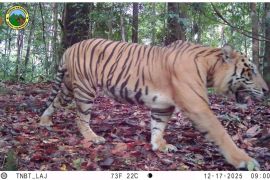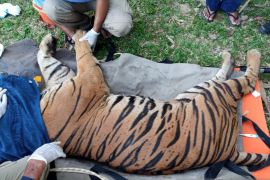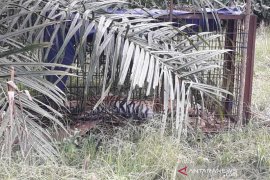The four native Indonesian baby animals with Latin name Panthera Tigris Sumatrae were born from male and female tigers, Harfan (10 years) and Mayang (7 years). These two tigers were lent by the Indonesian government to Germany in December 2013 as a form of close diplomatic relations between the two countries.
"The preservation of Sumatran tiger in Tierpark is a symbol of the closeness relations between Indonesia and Germany. The effort made by Tierpark to preserve Sumatran tiger is a real contribution in supporting the Indonesian government`s mission to preserve Sumatran tigers," Indonesian Ambassador to Germany Arif Havas Oegroseno said in a statement received by Antara here Friday.
At the introduction of the Sumatran baby tigers event, Ambassador Havas was present with Director of Tierpark Zoo Andreas Knieriem and a member of the Sparkasse Executive Board, Hans Jurgen Kularts.
The management of Tierpark Berlin asked Ambassador Havas to firstly give the name to one of the baby tigers, followed by Director of Tierpark Zoo Andreas Knieriem, representative of Sparkasse, and nurse of Sumatran tigers at the zoo.
The four Sumatran cub tigers are Kiara (female), Willi (male), Oscar (male), and Seri (female).
At the tiger introduction event Ambassador Havas specifically appreciated the success of Tierpark Zoo and Sparkasse, as a sponsor, in preserving one of Indonesia`s endangered animals.
In such different environment and climate from their native habitat in the Sumatran rainforest, experts at Tierpark Zoo have cared Harfan and Mayang so that they could live well and have four healthy cubs.
According to Knieriem, the new habitat in Tierpark is designed in such a way as to resemble the evergreen rainforest in Sumatra.
"We hope that these cubs can grow like if they livee in their natural habitat. In addition, we hope that the evergreen rainforest provides new perspectives and amazing facts for visitors about animals that live in the forest," he said.
Knieriem added that Sumatran tigers that grow in the man-made habitat at Tierpark Berlin would attract German public to get to know Indonesia.
"This is also the beginning for them (the four Sumatran baby tigers) to get familiar with new habitats surrounded by rocks," he said.
Usually, cub tigers can be separated from their mothers when they are around two years old. But, it is planned that in 2019, Kiara, Wili, Oscar and Seri will be moved to Tierpark`s New Rainforest in Alfred Brehm Building.
Data in 2018 show that the population of Sumatran tiger is around 600, increasing from that in the previous years which only around 400 tigers.
The increasing is indicated from the density of Sumatran tiger at 1.6 tiger per 100 square kilometer in 2002 to 2.8 tigers per 100 square kilometer in 2015.
"We are expecting that by 2022 the population of Sumatran tiger will double," Ambassador Havas said.
The Indonesian government is currently launching a program to accurately calculate the population of Sumatran tigers in the conservation forests.
The data collected through the program can be used to identify Sumatran tigers based on sex so that conservation measures can be carried out more directed.
"We will continue to work together with Germany to preserve Indonesia`s endangered species, not only with Tierpark Berlin, but also with all zoos in the country. Preserving other endangered species will also be cooperated with Germany," Ambassador Havas said.
Reporter: Antara
Editor: Andi Abdussalam
Copyright © ANTARA 2018












